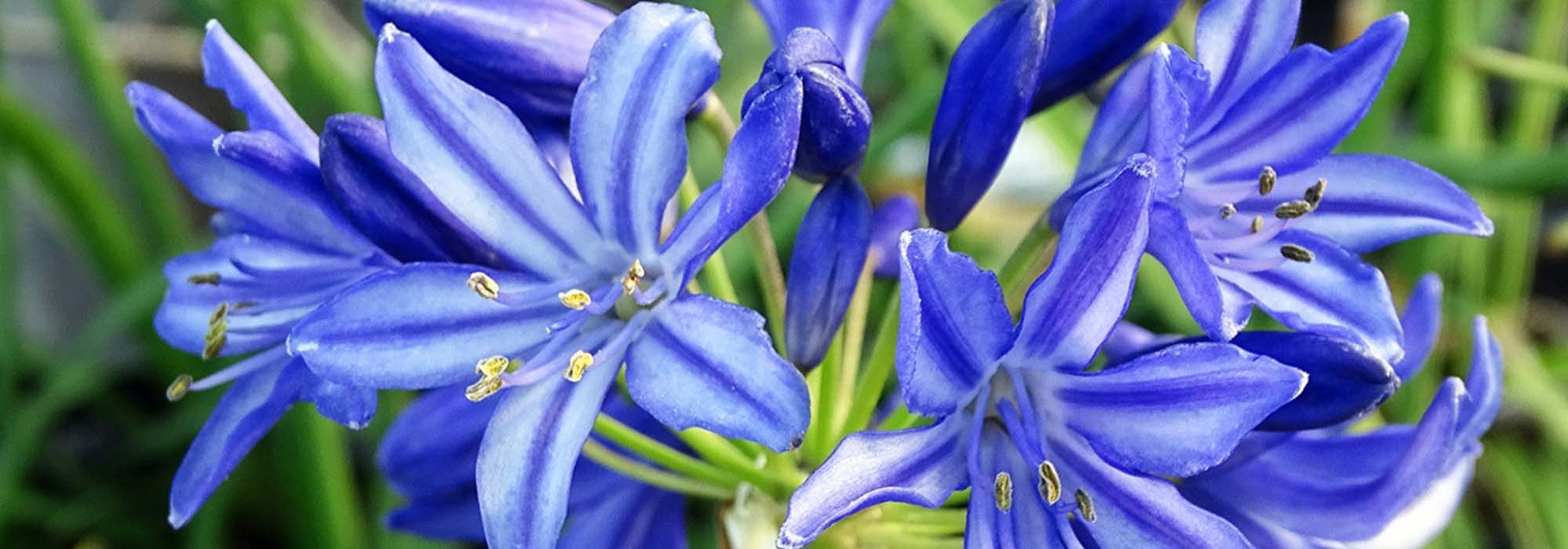
Agapanthus: planting, growing and care
Contents
Agapanthus in a nutshell
- Agapanthus form graceful blue flowers that dress gardens throughout summer.
- Striking and dynamic in gardens, they provide colourful vertical accents to decorate beds or borders with a light touch.
- Shades of agapanthus flowers come in a fabulous range of blues, violets and whites.
- From the hardiest to the least hardy, new agapanthus varieties allow them to be grown almost anywhere in France.
- Agapanthus are ideal in dry, sunny gardens.
A word from our expert
Agapanthus, those fabulous blue flowers charm us all. They are among the trendiest plants for landscapers! Popular with professionals, they also appeal to amateur gardeners. I no longer count how many times I’ve been asked to identify a very beautiful blue flower growing in Brittany. Each time, it was an agapanthus!
Graceful with light, upright flower spikes, agapanthus are appreciated for their bluish, purplish or white colours. In dry, sunny soil, agapanthus provide a colourful, vertical accent.
Easy to pair, they harmonise as well with mineral elements as with other vegetation. They are ideal in contemporary, minimalist, dry or more natural gardens. You’ll be charmed by pairing them with bushes pruned into balls or by using them on urban terraces.
Today their varied shades let you match them with colours of your choice and, above all, you can grow them everywhere. Indeed, regions north of the Loire are no longer disadvantaged: there are varieties such as Donau that are among the hardiest and tolerate down to -15°C. Agapanthus are no longer reserved for Mediterranean or coastal climates. But soil must be well-draining.
Easy to grow, agapanthus simply require summer watering and winter protection.
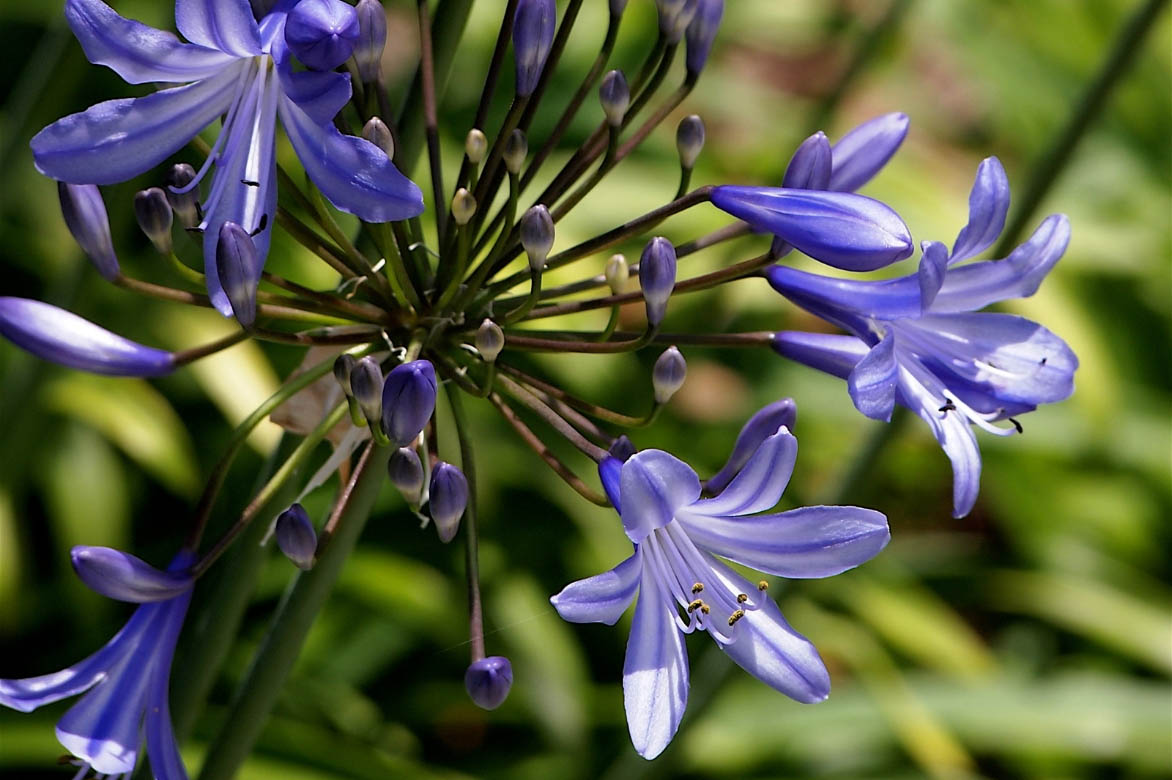
Blue-violet agapanthus flowers
Description and botany
Botanical data
- Latin name Agapanthus sp.
- Family Alliaceae - Liliaceae
- Common name Agapanthus, African agapanthus, Nile lily, blue tuberose
- Flowering May to September depending on species and climate
- Height 0.30 to 1.50 m
- Exposure full sun or sometimes partial shade
- Soil type light, rich and above all well-drained. All pH depending on variety.
- Hardiness -5°C to -15°C
Agapanthus are rhizomatous perennials native to South Africa, also called Nile lily, African agapanthus or blue tuberose. Naturally growing on rocky or sandy slopes of the Cape province, they were discovered in South Africa by a Dutchman in the 17th century. Today, genus Agapanthus includes around ten different species. The genus name Agapanthus comes from the Greek words agapê meaning ‘love’ and anthos meaning ‘flower’. Thus, Agapanthus poetically means ‘flower of love’. Highly honoured by Greek philosophers, the term Agapê represented for them the highest form of love, comparable to love of God.
In summer, flowering stems of Nile lilies rise above the foliage to form at their top a single spherical umbel, blue, violet or white. Each mature plant produces between 20 and 30 flowering stems in a season. These stems range from 30 cm to 1.5 m in height. Rigid, they withstand wind. They end with an umbel measuring between 10 and 20 cm in diameter. This umbel is formed of numerous flowers shaped like a trumpet opening into a star. Each flower has 6 petals fused at the base then opening and separating from one another. They are generally marked with a darker stripe in the centre. Flowers occur in a palette of colours ranging from blue, azure blue, blue-grey, blue-violet, violet and even white.
Foliage consists of strap-shaped green leaves 15 cm to 35 cm long. Leaves form a compact clump 20 to 50 cm in diameter. Leaves are deciduous or evergreen depending on species and varieties. Deciduous species have the advantage of being more cold-hardy than evergreen species.
 Agapanthus flowers come in many colours: white (Albus), lavender blue (Lavander Haze), sky blue, royal blue (Northern star), deep sea blue, bluish-purple, almost black violet (Black Magic).Agapanthus thrive in warm, sunny climates but cold tolerance depends on each variety. Thus, within genus Agapanthus there are varieties with low hardiness that cannot tolerate temperatures below -5°C. These are generally evergreen. They are mainly suited to coastal or Mediterranean regions where temperatures do not fall below -5°C. Agapanthus have even become emblematic plants of the Breton coastline. They require pot culture in regions with cold winters.
Agapanthus flowers come in many colours: white (Albus), lavender blue (Lavander Haze), sky blue, royal blue (Northern star), deep sea blue, bluish-purple, almost black violet (Black Magic).Agapanthus thrive in warm, sunny climates but cold tolerance depends on each variety. Thus, within genus Agapanthus there are varieties with low hardiness that cannot tolerate temperatures below -5°C. These are generally evergreen. They are mainly suited to coastal or Mediterranean regions where temperatures do not fall below -5°C. Agapanthus have even become emblematic plants of the Breton coastline. They require pot culture in regions with cold winters.
The other group within genus Agapanthus comprises deciduous varieties that can tolerate down to -10° to -15°C. Hardier, they can be grown almost everywhere in France provided they have good winter protection. Montane regions should still be avoided. This cold tolerance is due in particular to new Agapanthus varieties such as Navy Blue, which suit cooler regions very well.
Easy to grow, these blue tuberoses flourish if planted in a well-chosen spot. They do not like being moved. They need sun and warmth to flower. Regular summer watering is essential to see them bloom while winter protection is indispensable in cool and cold regions.
Agapanthus are suitable for flowerbeds and borders. They are very popular in contemporary gardens, dry gardens and even exotic gardens.
Agapanthus can also be used as cut flowers.
Read also
How to protect agapanthus over winter?Main species and varieties of Agapanthus
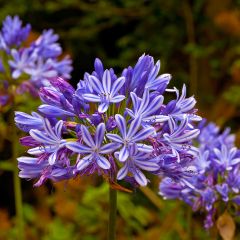
Agapanthus umbellatus
- Flowering time August to October
- Height at maturity 1 m
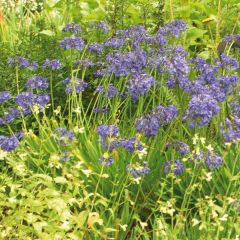
Agapanthus Headbourne Blue
- Flowering time August, September
- Height at maturity 80 cm
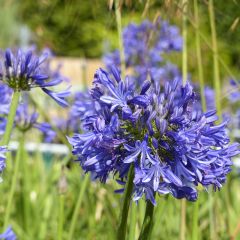
Agapanthus Navy Blue
- Flowering time August, September
- Height at maturity 60 cm
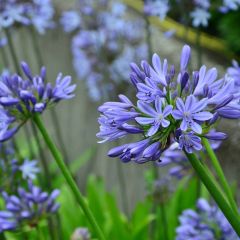
Agapanthus Blue Giant
- Flowering time August, September
- Height at maturity 1,50 m

Agapanthus Tinkerbell
- Flowering time August, September
- Height at maturity 60 cm
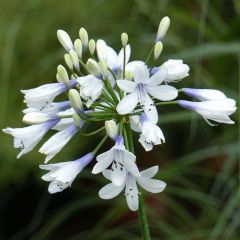
Agapanthus Twister
- Flowering time August, September
- Height at maturity 60 cm
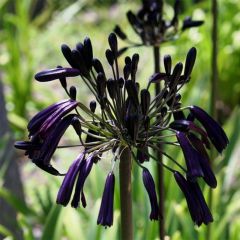
Agapanthus inapertus subsp. pendulus Black Magic
- Flowering time August, September
- Height at maturity 80 cm
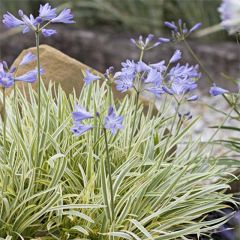
Agapanthus Golden Drop
- Flowering time July to September
- Height at maturity 40 cm
Discover also all our white agapanthus.
Discover other Agapanthus - Lily of the Nile
View all →Available in 0 sizes
Available in 1 sizes
Available in 5 sizes
Available in 2 sizes
Available in 0 sizes
Available in 2 sizes
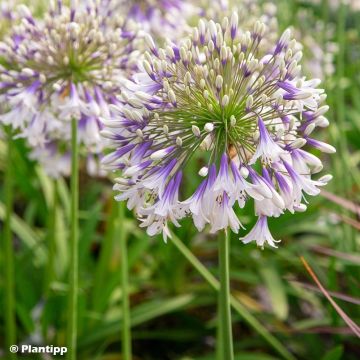
Available in 3 sizes
Available in 0 sizes
Available in 4 sizes
Available in 0 sizes
Planting Agapanthus
When to plant agapanthus?
To optimise growth and flowering of agapanthus, ideal time to plant is spring. This key period gives plants enough time to establish firm roots before winter temperatures arrive.
Where to plant agapanthus?
Position is crucial for successful cultivation of agapanthus. These sun-loving plants require warm conditions to thrive. Although some agapanthus varieties can adapt to partial shade, they flower more abundantly in full sun. Avoid planting under tree canopy where shade may be too dense for these light lovers.
Soil type also plays a decisive role for agapanthus. They prefer well-drained, fertile, light soil. Good drainage is essential to help agapanthus withstand cold spells. Sloping sites, banks or natural raised ground are ideal, preventing any waterlogging.
Although agapanthus tolerate wind and sea spray, it is sensible to protect them from strong winds that could damage their tall flowers. Their tolerance of sea spray makes them perfect candidates for coastal gardens.
Agapanthus suit a variety of garden contexts, from dry gardens to Mediterranean, contemporary, exotic styles, or urban terraces. Their dense foliage and spectacular inflorescences make them ideal for mass planting, pots or borders. For small spaces or edging, dwarf agapanthus varieties are particularly recommended, combining beauty and adaptability.

Dwarf agapanthus varieties are ideal in pots: Pitchoune Blue, Double Diamond and Golden Drop.
How to plant agapanthus?
Agapanthus, known for preferring to remain in place once planted, require careful attention from the moment location is chosen. Whether planting in open ground or in pots, each method has advantages, notably to protect less hardy varieties from cold.
Steps for planting in open ground :
- Preparing the hole : Dig a hole three times wider than size of the rootball.
- Soil amendment : Prepare a mix of one third garden soil, one third compost or potting compost, and one third sand to ensure optimal drainage. For heavy soils, use a mix of 50% potting compost and 50% sand.
- Clearing : Remove weeds and stones from the hole.
- Spacing : Space plants about 50 cm apart, equivalent to 3 to 5 plants per square metre, depending on their size at ripeness.
- Planting : For plants with bare roots, bury the stumps between 5 and 10 cm deep. If planting a rootball, ensure it is level with soil.
- Finishing : Backfill the hole with your soil mix, firm well and water thoroughly.
For agapanthus planted in open ground, regular watering is crucial, particularly during first years and summer months, to encourage good establishment and abundant flowering after 3 to 4 years.
For container growing :
- Choosing a pot : Select a pot slightly larger than the rootball or rootstock. Agapanthus thrive when planted relatively compactly.
- Drainage : Add a layer of clay pebbles to pot base to prevent excess moisture.
- Potting mix : Use a mix of 50% potting compost and 50% sand for filling.
- Planting : Insert rootball or rootstock into prepared mix.
Container culture suits compact varieties such as Pitchoune Blue. For more information, see our articles How to grow an Agapanthus in a pot?, Best agapanthus to grow in pots, and 5 agapanthus to grow in pots. Note that agapanthus are among plants that like to have roots confined!
In frost-prone regions, it is sensible to plant less-hardy agapanthus directly into pots set into soil of beds, a technique inspired by French-style gardens. That way, when winter approaches, pots can be lifted out of ground and sheltered easily.
Also find our blog article dedicated to planting agapanthus.
Caring for Agapanthus
Easy to grow, agapanthus require no pruning and are not prone to disease. Their only possible pests are slugs, which can eat young spring leaves on deciduous agapanthus.
Agapanthus prefer fairly rich soil. In the ground, fertilisers are not necessary. In pots, apply a slow‑release fertiliser rich in potassium and phosphorus once a year. Supplement with a liquid fertiliser once a month during spring. Fertiliser at this time helps boost plant’s regrowth and encourages summer flowering, which requires energy.
Agapanthus are mainly drought‑tolerant in winter. In summer, agapanthus need watering once or twice a week, ensuring soil is allowed to dry between waterings. This summer watering promotes flowering.
During summer, remove faded flowers as they appear by cutting the flower stem at the base. This prevents plant from using energy to form seeds and directs it to producing new flowers. However, if you wish to propagate your agapanthus by sowing, keep faded flowers so they can develop into seeds.
When cold arrives, do not remove leaves from agapanthus; they dry naturally in their own time.
In winter, winter protection is essential for your agapanthus. According to your climate and the varieties planted, follow our advice: “How to protect agapanthus over winter?
Once your agapanthus plant is established, it is advisable to divide it every 4 to 5 years to restore vigour and encourage abundant flowering.
Propagating Agapanthus
Dividing agapanthus
Best propagation technique for agapanthus is division. Carry out from March, ideally outside frost period. Division at this time allows plant to heal during spring while still dormant and for remainder of season before first winter frosts.
You need a rootstock large enough to be divided. To divide, simply:
- Extract your rootstock from soil using a digging fork.
- Divide your rootstock using a knife or spade into 3 or 4 pieces. Each piece must have at least one rootstock, one bud and one leaf if variety is evergreen.
- And plant your rootstock as described previously in Planting agapanthus.
For more information on pot culture, here is our full article on the division of agapanthus in pots.
Divisions of agapanthus allow multiplication of your plants but also restore vigour to older plants.
Sowing agapanthus
Sowing agapanthus is possible but longer and more difficult than division. Expect 4 years to obtain first flowers from a sowing. Moreover, seeds result from cross-breeding, so we cannot know in advance colours and shapes of future agapanthus.
To carry out a sowing of agapanthus, proceed in spring :
- Use seeds formed during previous year.
- Sow seeds thinly in a tray of seed compost.
- Cover seeds with a little compost.
- Place tray at about 18°C. Water lightly and continuously.
- Three weeks later, prick out your seedlings into a bucket. Water moderately.
- Six months later, repot your plants into a larger pot.
Companion planting Agapanthus in the garden
Agapanthus combine particularly well with the plant and the mineral. That’s also why landscape designers love them. They adapt equally well to contemporary, exotic, dry or natural gardens.
For a contemporary garden, pair agapanthus with stipa, perovskia, miscanthus, ornamental alliums and other bushes clipped into spheres such as crenate holly. The result is guaranteed!
For colour, consider creating a monochrome study in blues by pairing them with fescues, nepeta and perovskia. Also match agapanthus blue to the blue of your shutters, gate or other garden furniture. The effect will enhance your garden.

Or play with colours complementary to blue-violet:
- Orange: The copper-orange tones of crocosmias, Kniphofias, cannas and daylilies are stunning with violet-toned agapanthus such as Royal Velvet.
- The anise-green of foliage of alchemilla or of agastache ‘Golden Jubilee’.
- Grey and silver combine with the dark green of agapanthus foliage: artemisia, santolina, bear’s ear and sage.
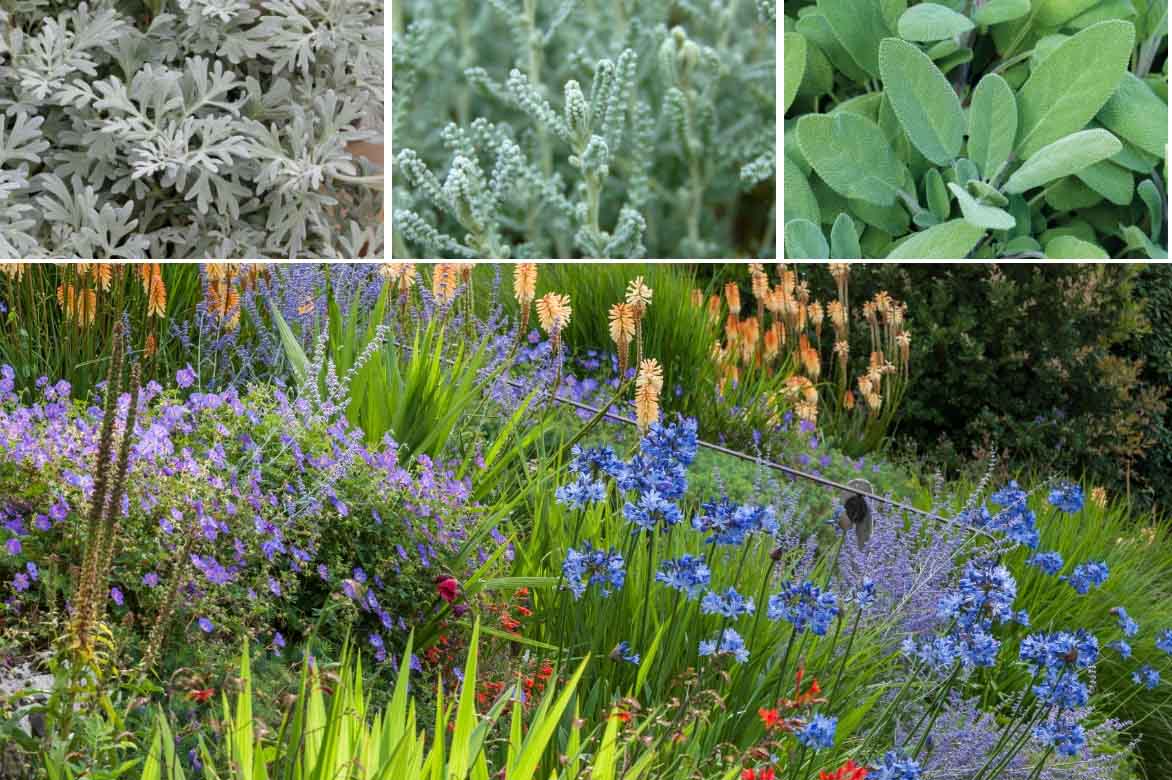
Pair the green of agapanthus foliage with the grey foliage of artemisia, santolina, or sage (Grower’s Friend). The violet of agapanthus flowers harmonises with the orange of crocosmias and Kniphofias.
In a garden with an exotic feel, pair agapanthus with cannas, gunneras, phormiums or Abyssinian gladioli.
For a more natural garden, accompany your agapanthus with grasses, apiaceae (formerly called umbellifers) and gaura.
Useful resources
- In our catalogue, all our Agapanthus varieties
- All our articles on Agapanthus: Everything you need to know about Agapanthus
- A benchmark contemporary garden by Alexandre Thomas: the Agapanthus garden
- 7 white Agapanthus to discover ; 7 blue Agapanthus ; Bicolour Agapanthus: 5 essential varieties ; Agapanthus with variegated foliage
- Evergreen Agapanthus
- Agapanthus: the 7 hardiest varieties
- How to grow Agapanthus in a pot? ; Best dwarf Agapanthus to make the garden bloom
- Which Agapanthus to plant in your region?
- What is the best place to plant Agapanthus?
- Discover “Agapanthus ‘Navy Blue’: a cold-hardy beauty”
- Read Olivier’s article: Are Agapanthus endangered?
- Join Gwenaëlle on a visit to Madeira, the island of flowers and discover how to design a garden inspired by Madeira, the island of flowers.
Frequently asked questions
-
My agapanthus leaves are turning yellow — what should I do?
Several reasons can cause your agapanthus plants' leaves to yellow. In summer, this will most likely be due to lack of watering. Indeed, your agapanthus plants, even planted in the open ground, require one to two waterings per week during the summer. Simply water accordingly and cut the yellow leaves back to the base. New, green leaves will follow. Be careful: if you have been diligent with watering and the base of your agapanthus plant is quite wet when you notice the yellowing, it is the opposite. Excess water causes the leaves to yellow and may rot the plant base. Remove water from saucers if you are growing in pots and water again when the soil is entirely dry. In autumn, if your agapanthus is deciduous, it is normal for foliage to yellow before falling. Leave the leaves to yellow and dry naturally. Remove them by cutting back to the base when spring returns.
-
My agapanthus lose their leaves in winter — what should I do?
There are deciduous and evergreen varieties of agapanthus. Your variety is probably deciduous; it is perfectly normal for it to lose its leaves in winter.
-
Why are my agapanthus in the ground less attractive than those in pots?
Agapanthus particularly like being grown in pots and appreciate being kept fairly crowded. With a little extra care, potted agapanthus can be even more beautiful than those grown in the ground. Even in the ground, it is essential to water plants at their base, up to twice a week in summer.
-
Should I add fertiliser to my agapanthus?
In the ground, agapanthus do not need fertiliser unless your soil is poor. In that case, apply compost as a surface dressing in spring. In pots, feeding is essential. Apply in spring a slow-release fertiliser rich in potash and phosphorus. Then, monthly, add liquid feed throughout spring and summer.
-
Why are my agapanthus not flowering?
If your agapanthus do not flower, several factors may be responsible. Firstly, they must be old enough (at least 4 years) and established (at least 3 years after planting). Next, watering must be consistent, especially in summer. In summer, two waterings per week are necessary for good flowering. In pots, an application of slow-release fertiliser is essential in spring. If they still do not flower, they probably lack sufficient sunlight and/or warmth.
-
How to prune agapanthus?
Agapanthus should not be pruned. Simply remove spent flowers as they fade by cutting the stem right back to the base.
- Subscribe!
- Contents
































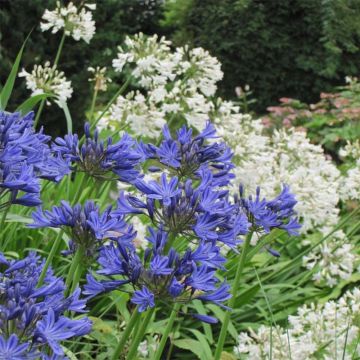
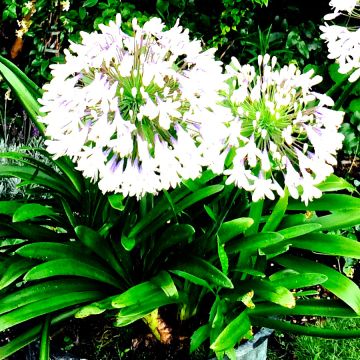
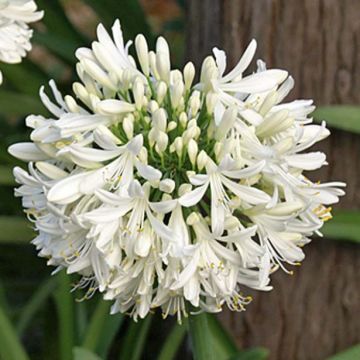
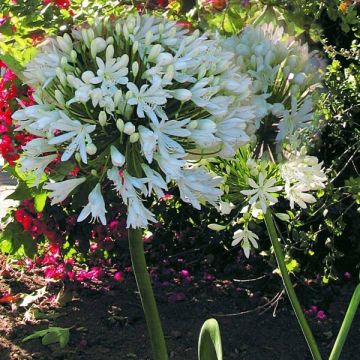
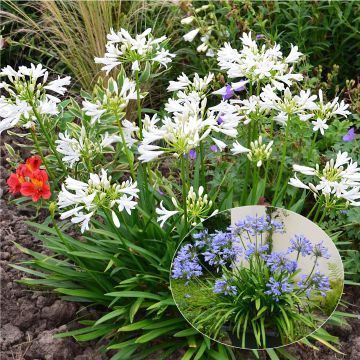
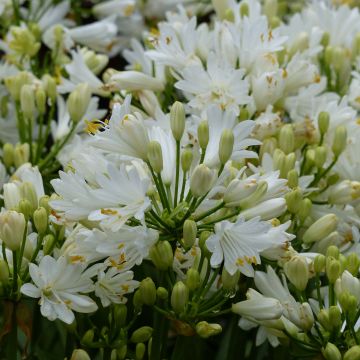
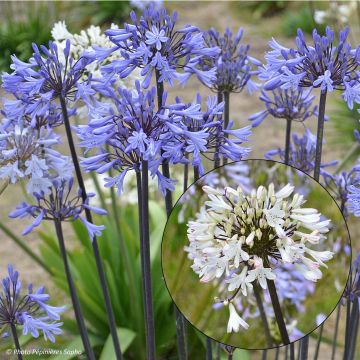

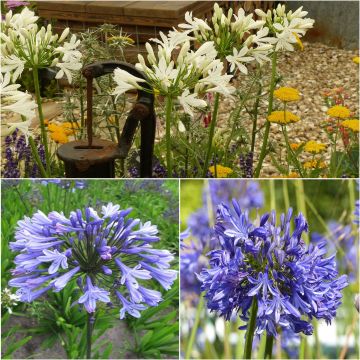
Comments